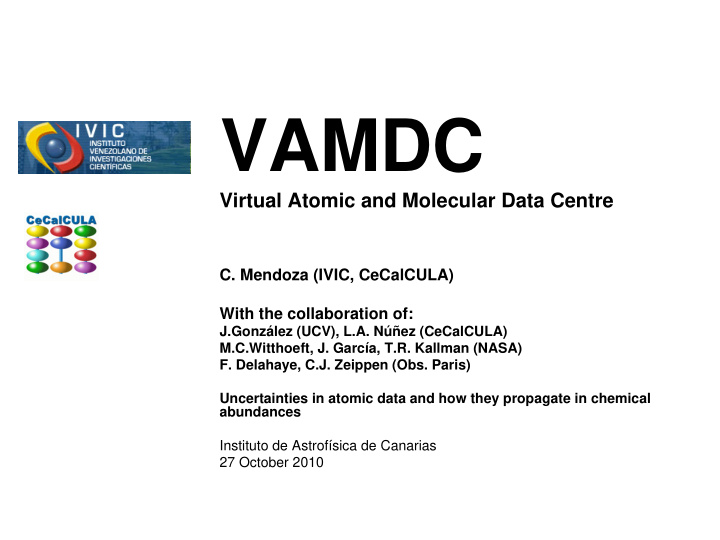



VAMDC Virtual Atomic and Molecular Data Centre C. Mendoza (IVIC, CeCalCULA) With the collaboration of: J.González (UCV), L.A. Núñez (CeCalCULA) M.C.Witthoeft, J. García, T.R. Kallman (NASA) F. Delahaye, C.J. Zeippen (Obs. Paris) Uncertainties in atomic data and how they propagate in chemical abundances Instituto de Astrofísica de Canarias 27 October 2010
• VAMDC aims at building an interoperable e-infrastructure for the exchange of atomic and molecular data. VAMDC involves 15 administrative partners representing 24 teams from 6 European Union member states, Serbia, the Russian Federation and Venezuela. • VAMDC is supported by EU in the framework of the FP7 "Research Infrastructures - INFRA-2008-1.2.2 - Scientific Data Infrastructures" initiative. It started on the 1rst of July for a duration of 42 months.
VAMDC integrates several research groups mainly from the European Research Area U Uppsala UCL U Cambridge Open U RAS U Cologne RFNC NIST Queen’s U CNRS U Vienna IVIC CeCalCULA AO Belgrade INA Italia
Users will navigate seamlessly and retrieve data from 21 A&M databases VALD NIST CHIANTI HITRAN CDMS OPserver BASECOL XSTAR STSP TIPbase UMIST VAMDC TOPbase KIDA PAH W@DIS LASP SPECTRA OZONE BELDATA CDSD SpecW3
A&M data are used in a wide variety of research and industrial fields Astrophysics Fusion plasmas Lighting Atmospheric physics Nanotechnology Environment S e m Lasers i c o n d u c t o r s
Outstanding problems in existing A&M databases are interoperability and data interfaces
VAMDC intends to deploy an interoperable e-environment for distributed A&M databases database2 database1 database3 database4
E- -science is collaborative data science is collaborative data- - E intensive science intensive science Original image from Hey, Tansley & Tolle (2009)
1 P 3pnp 1 Radiative decay decay of of 3pnp P states states in in Radiative Mg- -like like ions ions Mg Mg I 3pnp 1 P State RLT (ns) 3p4p 1 P 3.47E+00 3p5p 3.67E+00 3p5p 3.72E+00 3p6p 3.73E+00 3smp 1 P o 3p7p 3.74E+00 3p8p 3.75E+00 dominant channel: n = m 3p9p 3.78E+00 3p10p 3.87E+00 Butler et al (1990)
E-science is changing scientific research dynamics • Distributed computer environments •Virtual organizations •Grids •Clouds •Data-base centric computing •Warehousing (IVOA, VAMDC) •Data mining •Applications accessible as WSDL/SOAP web services •Service integrators •Scripts •Workflows •Social networks as end users •Data-curation environments •XML-based data exchange (XSAMS) •Metadata •Data preservation
The OPserver is a good example of database-centric computing OPserver at OSC From Mendoza et al. (2007)
Data exchange strategy VAMDC Source: Ralchenco et al., 2008, ICAMDATA-6, Beijing
VAMDC will provide a registry of A&M web services
The XSTAR spectral modeling code is being offered as a SOAP web service Command-based app XSTAR uaDB
Once XSTAR is available as a web service, it can be integrated in a web page
Once XSTAR is available as a web service, it can be integrated in a workflow system
Once XSTAR is available as a web service, it can be integrated in a workflow system Workflow inputs XSTAR std_output observed spectrum xspec Workflow outputs observed + synthetic spectra
The computation of astrophysical opacities would be a topical example for a workflow system Start RMO/RA Start RMO/RA Start RMO/RA Start RMO/RA Start RMO/RA Start RMO/RA Start RMO/RA Start RMO/RA Start RMO/RA EOS ionization fractions Atomic level populations DB application Opacity Code Mono application DB OPserver RMO/RA application End RMO/RA
Workflows maybe published in scientific social network systems
Workflow may become the blueprints of reproducible & adaptable scientific methods Source: myExperiment
Source: myExperiment We should attempt to form A&M data producer/user communities
OP Fe RMO at Z conditions conditions is is being being OP Fe RMO at Z questioned questioned Z conditions: T ~ 156 eV, n e ~ 10 22 cm -3 From Bailey (2008)
Model of the curation process Original image from Lord et al (2004)
Conclusions � Scientific research is becoming increasingly collaborative and data-intensive (e-science) � Atomic data production must be scaled up to the extreme requirements of virtual organizations � Data repositories must be kept fit and integral for contemporary purpose, discovery and reuse (e- science curation) � Data preservation is of vital importance
Recommend
More recommend